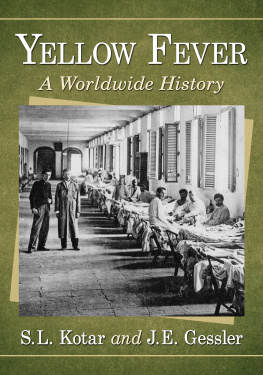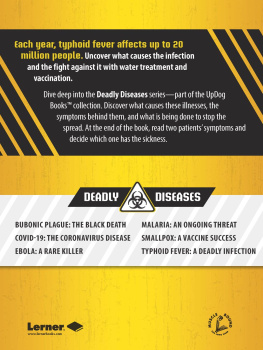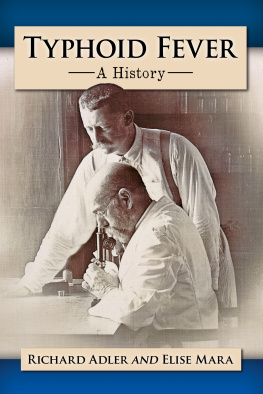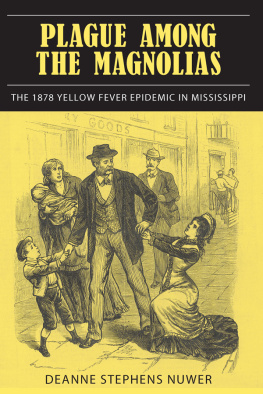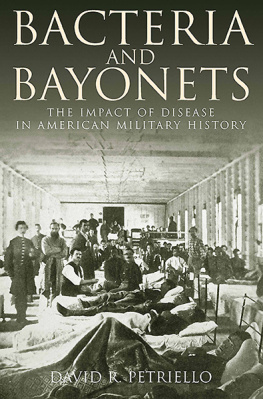
Also by S.L. KOTAR AND J.E. GESSLER AND FROM MCFARLAND
Cholera: A Worldwide History (2014)
Smallpox: A History (2013)
The Rise of the American Circus, 17161899 (2011)
Ballooning: A History, 17821900 (2011)
The Steamboat Era: A History of Fultons Folly on American Rivers, 18071860 (2009)
Yellow Fever
A Worldwide History
S.L. KOTAR and J.E. GESSLER

McFarland & Company, Inc., Publishers
Jefferson, North Carolina
LIBRARY OF CONGRESS CATALOGUING DATA ARE AVAILABLE
BRITISH LIBRARY CATALOGUING DATA ARE AVAILABLE
e-ISBN: 978-1-4766-2628-4
2017 S.L. Kotar. All rights reserved
No part of this book may be reproduced or transmitted in any form or by any means, electronic or mechanical, including photocopying or recording, or by any information storage and retrieval system, without permission in writing from the publisher.
Front cover image of patients in yellow fever hospital, Havana, Cuba, 1899 (Library of Congress)
McFarland & Company, Inc., Publishers
Box 611, Jefferson, North Carolina 28640
www.mcfarlandpub.com
To the Old Friend, always,
and to everyone on the Island
Acknowledgment
The authors gratefully acknowledge the dedication,
support and hard work done by Amy Christine
Zimmerman, without whose help this book
could never have been completed.
Preface
In developed nations of the 21st century the horrors of yellow fever are difficult to fathom. When considering the disease, images of the Panama Canal with infected mosquitoes buzzing around the heads of imported laborers probably comes to mind. Symptomology is likely vague: headaches, yellowness and fever would be the most common. It evokes shock to discover the staggering death tolls, in spite of the horrific cures, and horror to realize yellow fever was used as a form of biological warfare as early as the Civil War. Worse, it challenges the imagination to comprehend that yellow fever not only exists today in a deadly form but also presents complex health care problems to those poverty-stricken countries prone to the disease. But it is not only the people of Africa and South America who are threatened. Yellow fever exists today as a viable biological weapon and, potentially worse, viral fevers of the same class threaten the health of the world. Open a newspaper or scan the Internet and you are likely to find headlines capable of turning your blood cold. On November 30, 2015, for instance, in the St. LouisPost-Dispatch, one article began this way Brazil links dengue-like virus to birth defects in babies. This is living history that has the potential to reawaken and augment old horrors by making them new again.
The authors hope that by allowing readers to absorb words written by those who lived through these terrible times their agony can resonate as keenly today as it did hundreds of years ago and lead to a better understanding of the obstacles before us. Two contrasting views, both written by physicians in the first two decades of the nineteenth century, serve to illustrate the state of the medical practitioner and the patient, a state that has not appreciably changed since at least the 1500s:
When the vital energy sinks, it cannot be again revived; the benumbing poison of the contagion destroys it. The body of the patient then exhales miasmata, not perceptible to the senses, which attaches it to the bedding, clothes, furniture, and even the walls of the apartment, which then become capable of infecting individuals, more or less promptly.
All the violence of disease now rushed in upon me, hurrying on towards rapid destruction. The light was intolerable, and the pulsations of the head and eyes were most excruciatingconveying a sensation as if three or four hooks were fastened into the globe of each eye, and some person, standing behind me, was dragging them forcibly from their orbits back into the head, the cerebrum being, at the same time, detached from its membranes, and leaping about violently within the cranium. A wearying pain occupied my back and limbs, and in particular the calves of my legs, feeling as if dogs were gnawing down to the bones, while a tormenting restlessness possessed my whole frame, and totally prevented the slightest approach to ease or quiet. The skin was burning, and conveyed a pangent sensation when touched: the pulse was quickened but not very full; the tongue was white and parched, with excessive thirst and constant dryness of the mouth, lips, and teeth.
Yellow fever was well-known in Africa, South and Central America, the Caribbean and Mexico but it also adversely affected the southern latitudes of the United States. The disease was not exclusively limited to warm climates, however. In the early years of the United States it touched as far north as Boston, while striking Philadelphia (then the capital of the new nation) with plague-like ferocity that touched the lives of many of the Founding Fathers, as well as affected the reputation of Americas most famous physician, Dr. Benjamin Rush.
No authority of the times could explain the cause, much less offer proof of whether the disease was imported or of local origin. No method existed to make a definitive diagnosis, and treatments were varied, horrific and unsuccessful. The subject of quarantine became more of a political battle than a medical concern, evoking bitter, sometimes violent reactions from frightened people. African Americans were erroneously thought to be immune from the disease and were employed as nurses to treat the sick. Businessmen raged against restrictions on imported and exported goods that reduced their profit margins while, as always, more savvy entrepreneurs found ways to make a killing in the markets.
Complicating matters was the dissemination of information that either lessened or augmented national fears. For example, yellow fever came calling at New Orleans early in 1853. On Friday, July 22, Charity Hospital admitted 27 patients and discharged 44, while registering 48 deaths, 43 attributed to that dreaded malady. For the last week of July, as the New OrleansDelta was opining the disease was worse than ever before, the Charity reported 130 deaths.
As Delta newspapers were transported across the country by land and steamboat, exchange editors in other cities lifted articles and statistics, either publishing them verbatim or, more commonly, editing them as space dictated. If the reader were fortunate, appended to the beginning would be a nonspecific acknowledgment of source, such as, New Orleans papers of Sunday have been received. (Unfortunately, of course, the original source was not cited nor was the specific date. As the transfer of information was often delayed, Sunday might refer to one, two or even three weeks earlier.) In tracing the convoluted trail, the Zanesville (OH)Courier published the correct number of deaths (130) on July 30, 1853, having copied the statistics from a Philadelphia paper of the 29th. The editor of a Baltimore paper, however, either misread the number or a typesetter made a mistake in setting copy, as other exchanges garnering data from its July 30 issue listed mortality as being 190. Other than inadvertently adding 60 to the death toll, the paragraph from the Baltimore paper was identical. As the telegraph became the standard for transmitting information, timeliness was improved but the probability of human error remained constant.
Next page
